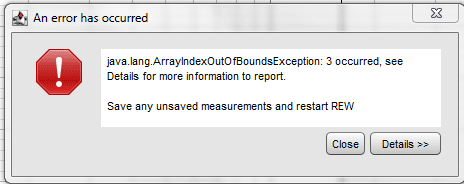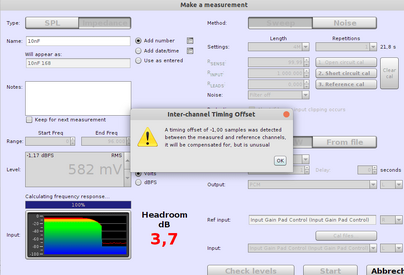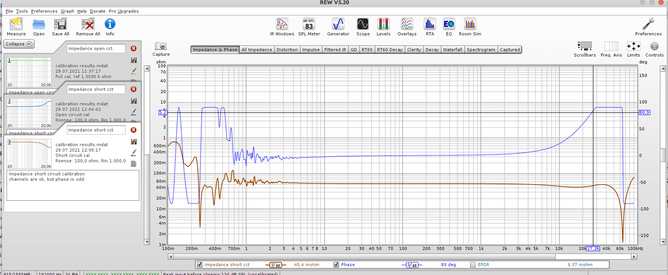jschwender
Member
More
- Front Speakers
- Nubert digital pro
- Other Speakers
- Philips dss940
After impedance measurement on a 10 nF precision reference glimmer capacitor, i click on component model and get repeatably that exception:
REW V5.20 running JRE 1.8.0_292 64-bit on linux 5.13.4-xeon, de, DE, UTF-8 at 93 DPI
Message:
java.lang.ArrayIndexOutOfBoundsException: 3
Stack Trace:
3
roomeqwizard.kG.ſ(y:208)
roomeqwizard.zH.paintComponent(y:3509)
javax.swing.JComponent.paint(JComponent.java:1056)
javax.swing.JComponent.paintChildren(JComponent.java:889)
javax.swing.JComponent.paint(JComponent.java:1065)
javax.swing.JComponent.paintChildren(JComponent.java:889)
javax.swing.JComponent.paint(JComponent.java:1065)
javax.swing.JLayeredPane.paint(JLayeredPane.java:586)
javax.swing.JComponent.paintChildren(JComponent.java:889)
javax.swing.JComponent.paint(JComponent.java:1065)
javax.swing.JLayer.paint(JLayer.java:433)
javax.swing.plaf.LayerUI.paint(LayerUI.java:79)
javax.swing.plaf.ComponentUI.update(ComponentUI.java:161)
javax.swing.JComponent.paintComponent(JComponent.java:780)
javax.swing.JLayer.paint(JLayer.java:428)
javax.swing.JComponent.paintChildren(JComponent.java:889)
javax.swing.JComponent.paint(JComponent.java:1065)
javax.swing.JComponent.paintChildren(JComponent.java:889)
javax.swing.JComponent.paint(JComponent.java:1065)
javax.swing.JComponent.paintChildren(JComponent.java:889)
javax.swing.JComponent.paint(JComponent.java:1065)
javax.swing.JComponent.paintChildren(JComponent.java:889)
javax.swing.JComponent.paint(JComponent.java:1065)
javax.swing.JLayer.paint(JLayer.java:433)
javax.swing.plaf.LayerUI.paint(LayerUI.java:79)
roomeqwizard.NB.paint(y:2131)
javax.swing.plaf.ComponentUI.update(ComponentUI.java:161)
javax.swing.JComponent.paintComponent(JComponent.java:780)
javax.swing.JLayer.paint(JLayer.java:428)
javax.swing.JComponent.paintChildren(JComponent.java:889)
javax.swing.JComponent.paint(JComponent.java:1065)
javax.swing.JComponent.paintToOffscreen(JComponent.java:5210)
javax.swing.RepaintManager$PaintManager.paintDoubleBuffered(RepaintManager.java:1579)
javax.swing.RepaintManager$PaintManager.paint(RepaintManager.java:1502)
javax.swing.BufferStrategyPaintManager.paint(BufferStrategyPaintManager.java:306)
javax.swing.RepaintManager.paint(RepaintManager.java:1272)
javax.swing.JComponent._paintImmediately(JComponent.java:5158)
javax.swing.JComponent.paintImmediately(JComponent.java:4969)
javax.swing.JLayer.paintImmediately(JLayer.java:415)
javax.swing.plaf.LayerUI.paintImmediately(LayerUI.java:717)
javax.swing.JLayer.paintImmediately(JLayer.java:410)
javax.swing.JComponent.paintImmediately(JComponent.java:4950)
javax.swing.JLayer.paintImmediately(JLayer.java:415)
javax.swing.plaf.LayerUI.paintImmediately(LayerUI.java:717)
javax.swing.JLayer.paintImmediately(JLayer.java:410)
javax.swing.JComponent.paintImmediately(JComponent.java:4950)
javax.swing.RepaintManager$4.run(RepaintManager.java:831)
javax.swing.RepaintManager$4.run(RepaintManager.java:814)
java.security.AccessController.doPrivileged(Native Method)
java.security.ProtectionDomain$JavaSecurityAccessImpl.doIntersectionPrivilege(ProtectionDomain.java:74)
javax.swing.RepaintManager.paintDirtyRegions(RepaintManager.java:814)
javax.swing.RepaintManager.paintDirtyRegions(RepaintManager.java:789)
javax.swing.RepaintManager.prePaintDirtyRegions(RepaintManager.java:738)
javax.swing.RepaintManager.access$1200(RepaintManager.java:64)
javax.swing.RepaintManager$ProcessingRunnable.run(RepaintManager.java:1732)
java.awt.event.InvocationEvent.dispatch(InvocationEvent.java:311)
java.awt.EventQueue.dispatchEventImpl(EventQueue.java:758)
java.awt.EventQueue.access$500(EventQueue.java:97)
java.awt.EventQueue$3.run(EventQueue.java:709)
java.awt.EventQueue$3.run(EventQueue.java:703)
java.security.AccessController.doPrivileged(Native Method)
java.security.ProtectionDomain$JavaSecurityAccessImpl.doIntersectionPrivilege(ProtectionDomain.java:74)
java.awt.EventQueue.dispatchEvent(EventQueue.java:728)
org.GNOME.Accessibility.AtkWrapper$6.dispatchEvent(AtkWrapper.java:705)
java.awt.EventDispatchThread.pumpOneEventForFilters(EventDispatchThread.java:205)
java.awt.EventDispatchThread.pumpEventsForFilter(EventDispatchThread.java:116)
java.awt.EventDispatchThread.pumpEventsForHierarchy(EventDispatchThread.java:105)
java.awt.EventDispatchThread.pumpEvents(EventDispatchThread.java:101)
java.awt.EventDispatchThread.pumpEvents(EventDispatchThread.java:93)
java.awt.EventDispatchThread.run(EventDispatchThread.java:82)
REW V5.20 running JRE 1.8.0_292 64-bit on linux 5.13.4-xeon, de, DE, UTF-8 at 93 DPI
Message:
java.lang.ArrayIndexOutOfBoundsException: 3
Stack Trace:
3
roomeqwizard.kG.ſ(y:208)
roomeqwizard.zH.paintComponent(y:3509)
javax.swing.JComponent.paint(JComponent.java:1056)
javax.swing.JComponent.paintChildren(JComponent.java:889)
javax.swing.JComponent.paint(JComponent.java:1065)
javax.swing.JComponent.paintChildren(JComponent.java:889)
javax.swing.JComponent.paint(JComponent.java:1065)
javax.swing.JLayeredPane.paint(JLayeredPane.java:586)
javax.swing.JComponent.paintChildren(JComponent.java:889)
javax.swing.JComponent.paint(JComponent.java:1065)
javax.swing.JLayer.paint(JLayer.java:433)
javax.swing.plaf.LayerUI.paint(LayerUI.java:79)
javax.swing.plaf.ComponentUI.update(ComponentUI.java:161)
javax.swing.JComponent.paintComponent(JComponent.java:780)
javax.swing.JLayer.paint(JLayer.java:428)
javax.swing.JComponent.paintChildren(JComponent.java:889)
javax.swing.JComponent.paint(JComponent.java:1065)
javax.swing.JComponent.paintChildren(JComponent.java:889)
javax.swing.JComponent.paint(JComponent.java:1065)
javax.swing.JComponent.paintChildren(JComponent.java:889)
javax.swing.JComponent.paint(JComponent.java:1065)
javax.swing.JComponent.paintChildren(JComponent.java:889)
javax.swing.JComponent.paint(JComponent.java:1065)
javax.swing.JLayer.paint(JLayer.java:433)
javax.swing.plaf.LayerUI.paint(LayerUI.java:79)
roomeqwizard.NB.paint(y:2131)
javax.swing.plaf.ComponentUI.update(ComponentUI.java:161)
javax.swing.JComponent.paintComponent(JComponent.java:780)
javax.swing.JLayer.paint(JLayer.java:428)
javax.swing.JComponent.paintChildren(JComponent.java:889)
javax.swing.JComponent.paint(JComponent.java:1065)
javax.swing.JComponent.paintToOffscreen(JComponent.java:5210)
javax.swing.RepaintManager$PaintManager.paintDoubleBuffered(RepaintManager.java:1579)
javax.swing.RepaintManager$PaintManager.paint(RepaintManager.java:1502)
javax.swing.BufferStrategyPaintManager.paint(BufferStrategyPaintManager.java:306)
javax.swing.RepaintManager.paint(RepaintManager.java:1272)
javax.swing.JComponent._paintImmediately(JComponent.java:5158)
javax.swing.JComponent.paintImmediately(JComponent.java:4969)
javax.swing.JLayer.paintImmediately(JLayer.java:415)
javax.swing.plaf.LayerUI.paintImmediately(LayerUI.java:717)
javax.swing.JLayer.paintImmediately(JLayer.java:410)
javax.swing.JComponent.paintImmediately(JComponent.java:4950)
javax.swing.JLayer.paintImmediately(JLayer.java:415)
javax.swing.plaf.LayerUI.paintImmediately(LayerUI.java:717)
javax.swing.JLayer.paintImmediately(JLayer.java:410)
javax.swing.JComponent.paintImmediately(JComponent.java:4950)
javax.swing.RepaintManager$4.run(RepaintManager.java:831)
javax.swing.RepaintManager$4.run(RepaintManager.java:814)
java.security.AccessController.doPrivileged(Native Method)
java.security.ProtectionDomain$JavaSecurityAccessImpl.doIntersectionPrivilege(ProtectionDomain.java:74)
javax.swing.RepaintManager.paintDirtyRegions(RepaintManager.java:814)
javax.swing.RepaintManager.paintDirtyRegions(RepaintManager.java:789)
javax.swing.RepaintManager.prePaintDirtyRegions(RepaintManager.java:738)
javax.swing.RepaintManager.access$1200(RepaintManager.java:64)
javax.swing.RepaintManager$ProcessingRunnable.run(RepaintManager.java:1732)
java.awt.event.InvocationEvent.dispatch(InvocationEvent.java:311)
java.awt.EventQueue.dispatchEventImpl(EventQueue.java:758)
java.awt.EventQueue.access$500(EventQueue.java:97)
java.awt.EventQueue$3.run(EventQueue.java:709)
java.awt.EventQueue$3.run(EventQueue.java:703)
java.security.AccessController.doPrivileged(Native Method)
java.security.ProtectionDomain$JavaSecurityAccessImpl.doIntersectionPrivilege(ProtectionDomain.java:74)
java.awt.EventQueue.dispatchEvent(EventQueue.java:728)
org.GNOME.Accessibility.AtkWrapper$6.dispatchEvent(AtkWrapper.java:705)
java.awt.EventDispatchThread.pumpOneEventForFilters(EventDispatchThread.java:205)
java.awt.EventDispatchThread.pumpEventsForFilter(EventDispatchThread.java:116)
java.awt.EventDispatchThread.pumpEventsForHierarchy(EventDispatchThread.java:105)
java.awt.EventDispatchThread.pumpEvents(EventDispatchThread.java:101)
java.awt.EventDispatchThread.pumpEvents(EventDispatchThread.java:93)
java.awt.EventDispatchThread.run(EventDispatchThread.java:82)

















